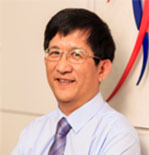Prof Soong Tuck Wah
 Soong Tuck Wah
Soong Tuck Wah
Professor, Department of Physiology
Yong Loo Lin School of Medicine
Tel: 6516 1938
Email: phsstw@nus.edu.sg
What are your present research interests or distinctive viewpoint to your research?
My lab is interested to understand the physiological significance of diversification of voltage-gated calcium (CaV) channels in the nervous and cardiovascular systems. Understanding physiology should help us understand disease. Our distinctive viewpoint is that context of the splice pattern arrayed in the CaV channel is critical to understanding brain region- or tissue-specific phenotypes in disease. This context is also important for determining differences in pharmacological responses, as well for differentiating the roles played by splice variants in various cell-types and subcellular compartments. The context also determines modulation of CaV channels by interacting cytoplasmic proteins to expand further on function.
What do you see as your future research directions?
Our lab’s research has been guided by where the roles of the channels may take us to ask specific questions. We anticipate we will move in the directions of understanding the roles played by CaV1.3 channels in circadian rhythm and feeding behaviour, by CaV1.2 in neuropsychiatric and neurodegenerative diseases and by CaV2.1 in movement disorder.
Does your laboratory have a particularly strong research expertise?
We have the knowledge and know-how to quickly transcript-scan to discover comprehensively the suite of alternatively spliced exons within the ORF of a gene. We have expertise in in-vitro electrophysiological techniques.
Recent Publications
- Bartels P, Yu D, Huang H, Hu Z, Herzig S, Soong TW.Alternative splicing at N-terminus and domain I modulates Cav1.2 inactivation and surface expression. Biophysical Journal. 2018, May 8;114(9):2095-2106
- Hu Z, Li G, Wang JW, Chong SY, Yu D, Wang X, Soon JL, Liang MC, Wong, YP, Huang N, Colecraft HM, Liao P, Soong TW Regulation of Blood Pressure by Targeting CaV1.2-Galectin-1 Protein Interaction. Circulation. 2018 Oct 2;138(14):1431-1445. doi: 10.1161/CIRCULATIONAHA.117.031231. PMID:29650545
- Hua Huang, Katannya Kapeli, Wenhao Jin, Yuk Peng Wong, Thiruma Valavan Arumugam, Joanne Huifen Koh, Sumitra Srimasorn, Karthik Mallilankaraman, John Jia En Chua, Gene W. Yeo and Tuck Wah Soong Tissue-selective restriction of RNA editing of CaV1.3 by splicing factor SRSF9 Nucleic Acids Res. 2018 Aug 21;46(14):7323-7338. doi:10.1093/nar/gky348.
- Liu C, Zhang CW, Lo SQ, Ang ST, Chew KCM, Yu D, Chai BH, Tan B, Tsang F, Tai YK, Tan BWQ, Liang MC, Tan HT, Tang JY, Lai MKP, Chua JJE, Chung MCM, Khanna S, Lim KL, Soong TW. S-nitrosylation of divalent metal transporter 1 enhances iron uptake to mediate loss of dopaminergic neurons and motoric deficit. J Neurosci.2018 Sep 26;38(39):8364-8377. doi: 10.1523/JNEUROSCI.3262 17.2018. Epub 2018 Aug 13. PubMed PMID: 30104344
- Shawn Tan, Yixin Xia, Henry H. Yin, Albert I. Chen, Tuck Wah Soong, and H. Shawn Je. Postnatal TrkB ablation in corticolimbic interneurons induces social dominance in male mice. Proc Natl Acad Sci U S A. 2018 Oct16;115(42):E9909-E9915. doi:10.1073/pnas.1812083115.

